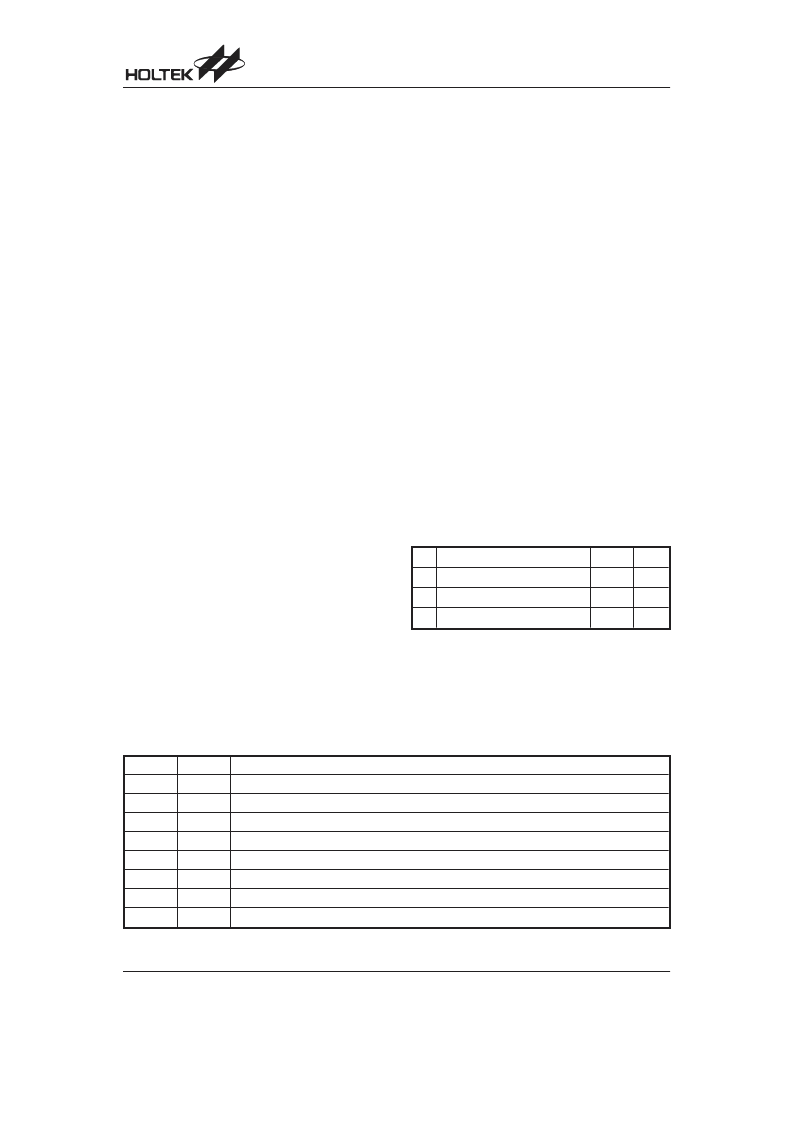- 您現(xiàn)在的位置:買(mǎi)賣(mài)IC網(wǎng) > PDF目錄385403 > HT82A821R (Holtek Semiconductor Inc.) USB Audio MCU PDF資料下載
參數(shù)資料
| 型號(hào): | HT82A821R |
| 廠商: | Holtek Semiconductor Inc. |
| 英文描述: | USB Audio MCU |
| 中文描述: | USB音頻控制器 |
| 文件頁(yè)數(shù): | 9/39頁(yè) |
| 文件大小: | 275K |
| 代理商: | HT82A821R |
第1頁(yè)第2頁(yè)第3頁(yè)第4頁(yè)第5頁(yè)第6頁(yè)第7頁(yè)第8頁(yè)當(dāng)前第9頁(yè)第10頁(yè)第11頁(yè)第12頁(yè)第13頁(yè)第14頁(yè)第15頁(yè)第16頁(yè)第17頁(yè)第18頁(yè)第19頁(yè)第20頁(yè)第21頁(yè)第22頁(yè)第23頁(yè)第24頁(yè)第25頁(yè)第26頁(yè)第27頁(yè)第28頁(yè)第29頁(yè)第30頁(yè)第31頁(yè)第32頁(yè)第33頁(yè)第34頁(yè)第35頁(yè)第36頁(yè)第37頁(yè)第38頁(yè)第39頁(yè)

HT82A821R
Rev. 1.10
9
June 29, 2007
the interrupt request flag is recorded. If a certain inter-
rupt requires servicing within the service routine, the
EMI bit and the corresponding bit of the INTC may be
set to allow interrupt nesting. If the stack is full, the inter-
rupt request will not be acknowledged, even if the re-
lated interrupt is enabled, until the SP is decremented. If
immediate service is desired, the stack must be pre-
vented from becoming full.
All these kinds of interrupts have a wake-up capability.
As an interrupt is serviced, a control transfer occurs by
pushing the program counter onto the stack, followed by
a branch to a subroutine at a specified location in the
program memory. Only the program counter is pushed
onto the stack. If the contents of the register or status
register (STATUS) are altered by the interrupt service
program which corrupts the desired control sequence,
the contents should be saved in advance.
The USB interrupts are triggered by the following USB
events and the related interrupt request flag (USBF; bit
4 of the INTC0) will be set.
Access of the corresponding USB FIFO from PC
The USB suspend signal from PC
The USB resume signal from PC
USB Reset signal
When the interrupt is enabled, the stack is not full and
the external interrupt is active, a subroutine call to loca-
tion 04H will occur. The interrupt request flag (USBF)
and EMI bits will be cleared to disable other interrupts.
When PC Host access the FIFO of the HT82A821R, the
corresponding request bit of USR is set, and a USB in-
terrupt is triggered. So user can easy to decide which
FIFO is accessed. When the interrupt has been served,
the corresponding bit should be cleared by firmware.
When HT82A821R receive a USB Suspend signal from
Host PC, the suspend line (bit0 of USC) of the
HT82A821RissetandaUSBinterruptisalsotriggered.
When the HT82A821R receives a Resume signal from
the Host PC, the resume line (bit3 of the USC) of the
HT82A821R are set and a USB interrupt is triggered.
Also when HT82A821R receive a Resume signal from
Host PC, the resume line (bit3 of USC) of HT82A821R is
set and a USB interrupt is triggered.
The internal Timer/Event Counter 0 interrupt is initial-
ized by setting the Timer/Event Counter 0 interrupt re-
quest flag (bit 5 of INTC0), caused by a timer 0 overflow.
When the interrupt is enabled, the stack is not full and
the T0F bit is set, a subroutine call to location 08H will
occur. The related interrupt request flag (T0F) will be re-
setandtheEMIbitclearedtodisablefurtherinterrupts.
The internal Timer/Even Counter 1 interrupt is initialized
by setting the Timer/Event Counter 1 interrupt request
flag (bit 6 of INTC0), caused by a timer 1 overflow. When
the interrupt is enabled, the stack is not full and the T1F
is set, a subroutine call to location 0CH will occur. The
related interrupt request flag (T1F) will be reset and the
EMI bit cleared to disable further interrupts.
During the execution of an interrupt subroutine, other in-
terrupt acknowledge signals are held until the RETI in-
struction is executed or the EMI bit and the related
interrupt control bit are set to 1 (if the stack is not full). To
return from the interrupt subroutine, RET or RETI
may be invoked. RETI will set the EMI bit to enable an
interrupt service, but RET will not.
Interrupts, occurring in the interval between the rising
edges of two consecutive T2 pulses, will be serviced on
the latter of the two T2 pulses, if the corresponding inter-
rupts are enabled. In the case of simultaneous requests
the following table shows the priority that is applied.
These can be masked by resetting the EMI bit.
No.
Interrupt Source
Priority Vector
a
USB interrupt
1
04H
b
Timer/Event Counter 0 overflow
2
08H
c
Timer/Event Counter 1 overflow
3
0CH
It is recommended that a program does not use the
CALL subroutine within the interrupt subroutine. Inter-
rupts often occur in an unpredictable manner or need to
be serviced immediately in some applications. If only
one stack is left and enabling the interrupt is not well
controlled, the original control sequence will be dam-
aged once the CALL operates in the interrupt subrou-
tine.
Bit No.
Label
Function
0
EMI
Controls the master (global) interrupt (1=enable; 0=disable)
1
EUI
Controls the USB interrupt (1=enable; 0= disable)
2
ET0I
Controls the Timer/Event Counter 0 interrupt (1=enable; 0=disable)
3
ET1I
Controls the Timer/Event Counter 1 interrupt (1=enable; 0=disable)
4
USBF
USB interrupt request flag (1=active; 0=inactive)
5
T0F
Internal Timer/Event Counter 0 request flag (1:active; 0:inactive)
6
T1F
Internal Timer/Event Counter 1 request flag (1:active; 0:inactive)
7
Unused bit, read as 0
INTC0 (0BH) Register
相關(guān)PDF資料 |
PDF描述 |
|---|---|
| HT82A821R_07 | USB Audio MCU |
| HT82A822R | USB Audio MCU |
| HT82A822R_07 | USB Audio MCU |
| HT82A832R | Basic USB Phone OTP MCU |
| HT82A850R | Audio MCU |
相關(guān)代理商/技術(shù)參數(shù) |
參數(shù)描述 |
|---|---|
| HT82A821R_07 | 制造商:HOLTEK 制造商全稱(chēng):Holtek Semiconductor Inc 功能描述:USB Audio MCU |
| HT82A822R | 制造商:HOLTEK 制造商全稱(chēng):Holtek Semiconductor Inc 功能描述:USB Audio MCU |
| HT82A822R_07 | 制造商:HOLTEK 制造商全稱(chēng):Holtek Semiconductor Inc 功能描述:USB Audio MCU |
| HT82A824R | 制造商:HOLTEK 制造商全稱(chēng):Holtek Semiconductor Inc 功能描述:USB Audio MCU |
| HT82A832R | 制造商:HOLTEK 制造商全稱(chēng):Holtek Semiconductor Inc 功能描述:USB Audio MCU |
發(fā)布緊急采購(gòu),3分鐘左右您將得到回復(fù)。